When the giantess Angrboda bore three monstrous children with the trickster god Loki, Odin banished them, rightfully fearing they'd spark the doomsday event known as Ragnarök.
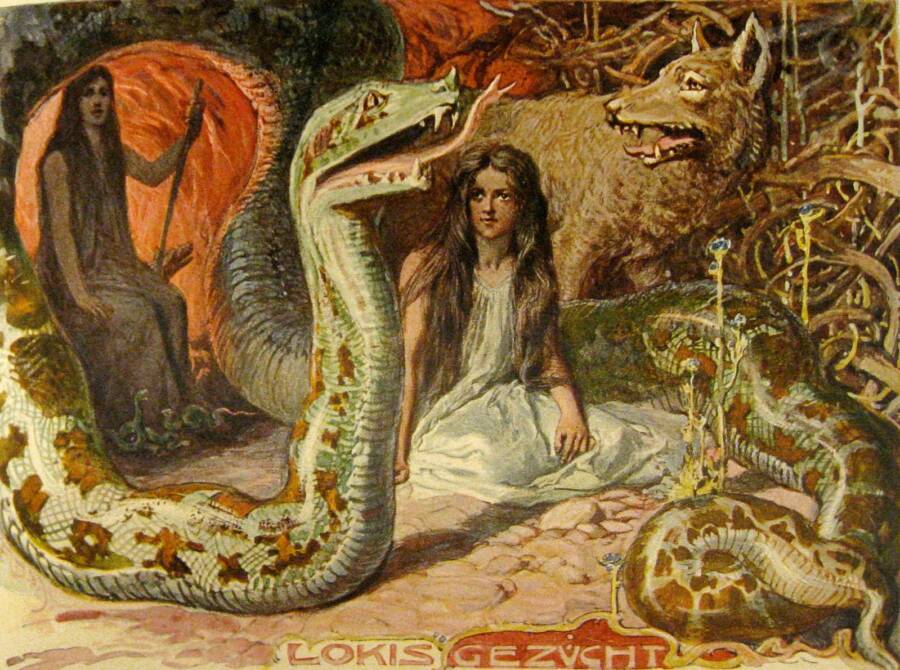
Wikimedia CommonsAngrboda and her monstrous children, Hel (left), Jörmungandr (center-left) and Fenrir (right).
For centuries before the spread of Christianity, Norse mythology offered vivid narratives of dramatic deities to the people of northern Europe. Many of these stories are focused on the complicated lives of the jötnar — a legion of supernatural giants — and their apocalyptic clashes with the gods.
Central to this struggle is the giantess Angrboda. A female jötunn of shadowy origins, Angrboda was said to have the ability to shape-shift into animals and was known as “the mother of monsters.” Her name ominously translates from Old Norse to “she who offers sorrow,” “the one who brings grief,” or “harm-bidder” — which proved rather apt.
The mythology around her leaves much to be desired, as Angrboda is mentioned only once by name in the Poetic Edda, a seminal collection of Old Norse poems. However, the text does reveal her to be a lover of the trickster god Loki, with whom she had three monstrous children.
It was said that these children would eventually lead to the end of the world — in the doomsday event known as Ragnarök. This is the mysterious story of Angrboda.
Inside The Norse Myth Of Angrboda
Many scholars believe that Angrboda is a relatively modern creation — no older than the 12th century C.E.
The Icelandic Codex Regius, the most famous version of the Poetic Edda, references the giantess in a poem titled “Völuspá” — which tells the story of the world’s creation and its eventual doom. Written around 1270, this particular piece of Old Norse folklore notably hints that Angrboda’s offspring would contribute to the apocalypse.
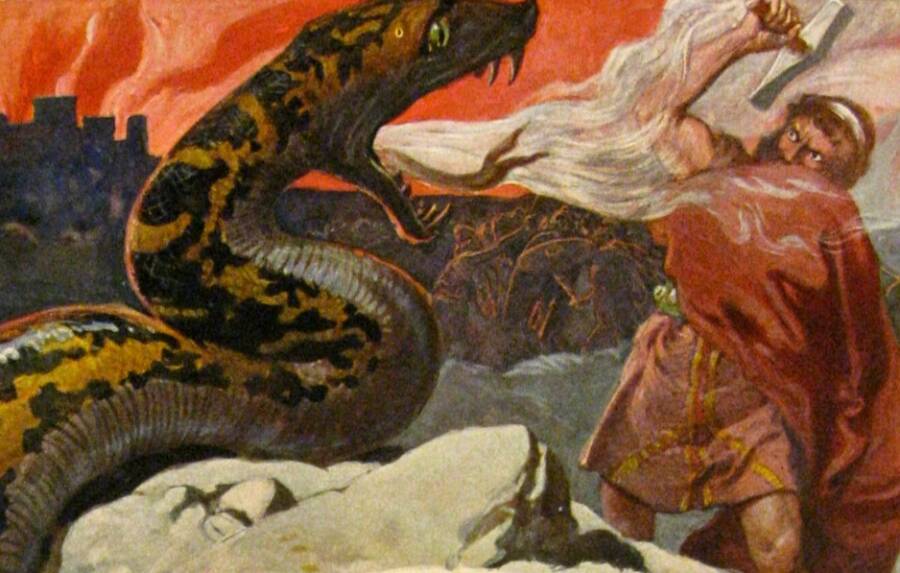
Wikimedia CommonsThor and the Midgard Serpent” (1905), depicting their fight during Ragnarök.
“Loki sired the wolf on Angrboda, and got Sleipnir on Svadilfari; the witch alone seemed most evil, the one that came from the brother of Byleipt,” it reads, according to a translation in John Lindow’s Norse Mythology: A Guide to Gods, Heroes, Rituals, and Beliefs. Many scholars believe the “wolf” refers to the monster Fenrir.
According to legend, Angrboda has three children by Loki: Fenrir the wolf, Jörmungandr the serpent, and Hel, the goddess of the underworld. These monsters, it was said, would help bring about Ragnarök.
The Mother Of Monsters
A companion to the Poetic, the Prose Edda describes the consequences of Angrboda’s breeding in a text titled “Gylfaginning.” Compiled by Icelandic historian Snorri Sturluson around 1220 C.E. and translated by Berkeley professor Arthur Gilchrist Brodeur in 1916, it outlines Angrboda’s role in the end of the world.
“Yet more children had Loki,” it reads. “Angrboda was the name of a certain giantess in Jötunheim, with whom Loki gat three children: one was Fenris-Wolf, the second Jörmungandr — that is the Midgard Serpent — the third is Hel.”
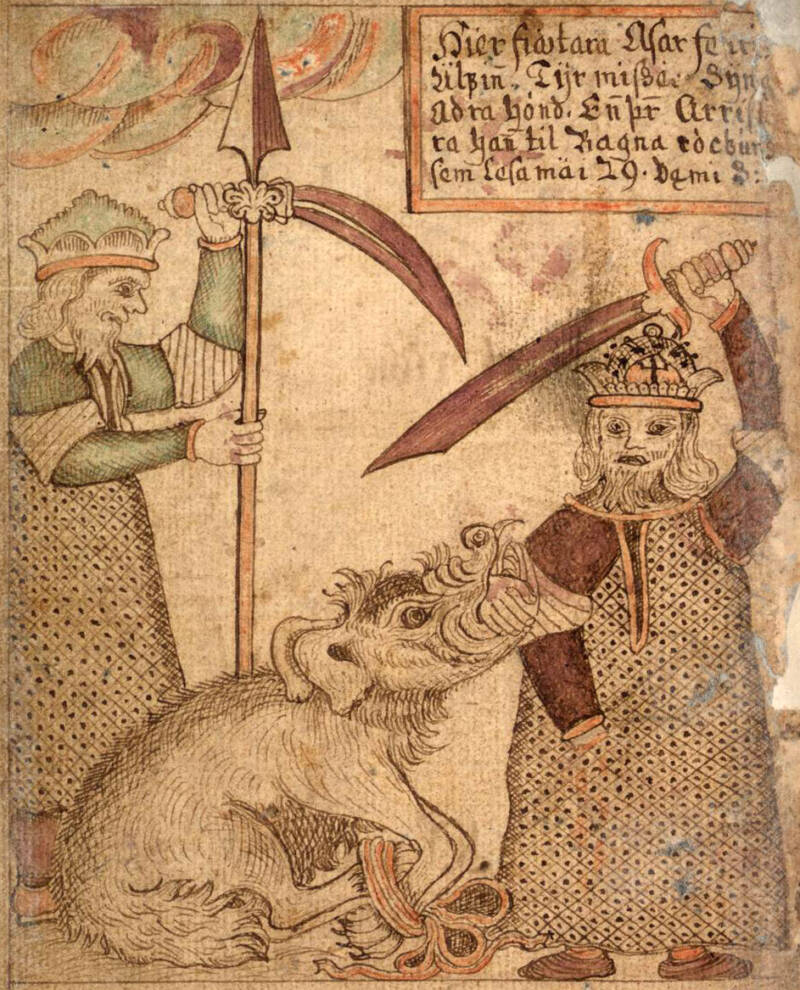
Wikimedia CommonsAn 18th-century illustration of Fenrir biting off the hand of the god Tyr while being chained.
Another passage warns of “a certain giantess,” a mother of many giants who would eventually “swallow heavenly bodies and spatter heaven and all the skies with blood.”
This battle between Angrboda’s children and the Norse gods would be christened “Ragnarök” — the burning of the world.
The Prophesy About Angrboda’s Children
Norse mythology organized the universe into nine different realms: Asgard, Midgard, Jötunheim, Niflheim, Muspelheim, Helheim, Alfheim, Svartalfheim, and Vanaheim. The gods and the Jötnar respectively denoted order and chaos — though both groups were just as prone to betray their own kind when dire conflict arose.
This was arguably a central theme of Angrboda’s story, as she and Loki became lovers and had children together only for their relationship to disintegrate. Loki, who was already of questionable loyalty to the gods, purportedly unnerved Odin — the All-Father of all the Norse gods — when he partnered with the giantess.
According to legend, it had been foretold that these children would bring an end to the nine realms forever. Notably, it was said that during Ragnarök, Fenrir would devour the sun and swallow Odin himself.
“The gods perceived by prophecy that from this kindred great misfortune should befall them,” a passage of the Prose Edda reads. “It seemed to all that there was great prospect of ill — (first from the mother’s blood, and yet worse from the father’s).”
Ragnarök, The “Doom Of The Gods”
Fearing the prophesy, Odin sent the gods to capture Angrboda’s three monstrous children. They were then separated and banished to three different realms.
Hel was cast out to the icy underworld realm of Niflheim, where men who die of sickness and old age are sent. Later, she will grant Loki an army of the dead as he marches against the gods during Ragnarök.
Jörmungandr, who is fated to kill Thor, was thrown into the sea. The beast grew so colossal that he eventually surrounded the entire planet — and was able to bite his own tail. Come Ragnarök, he will release his tail and rise from the sea, spraying his poisonous venom into the air.
Fenrir was initially brought to Asgard, until the gods learned he couldn’t be controlled. He then arguably received the worst punishment of all.
The wolf was taken to an island and tied to a rock with a magical chain purportedly made of the sound of a cat’s footsteps, the beard of a women, the breath of fish, and other occultist elements. He was then gagged with a sword and left there to live out his immortal life bound and in agony — until Ragnarök.
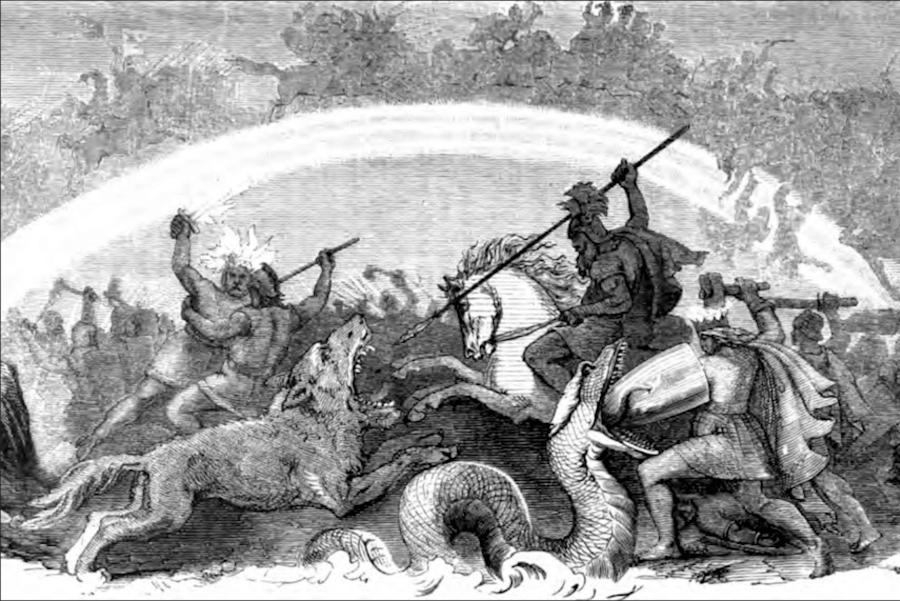
Wikimedia CommonsAn illustration from 1882 of Odin riding into battle during Ragnarök to fight Fenrir.
As described in “Völuspá,” Ragnarök inevitably breaks out. After a period of endless, harsh winters and moral confusion amongst gods and men, the giants attack the gods. The sun darkens, the stars disappear, and the Earth is swallowed by the sea as Angrboda’s children finally fulfill their destiny, bringing about the gods’ demise.
According to some versions of the legend, the world then resurfaces — and is repopulated by two surviving humans.
Angrboda In Popular Culture Today
Angrboda garnered renewed interest when video game developer Santa Monica Studio released God of War: Ragnarok in 2022. While most of the previous installments of this franchise focused squarely on Greek mythology, Ragnarok narrowed in on the myths and legends of Old Norse culture.
The game expectedly included characters such as Fenrir, Jörmungandr, and Hel — but portrayed them far differently than the Prose or Poetic Edda ever did. With little to draw from regarding Angrboda’s mention in the poems, the writers of God of War constructed an original narrative for the giantess character.
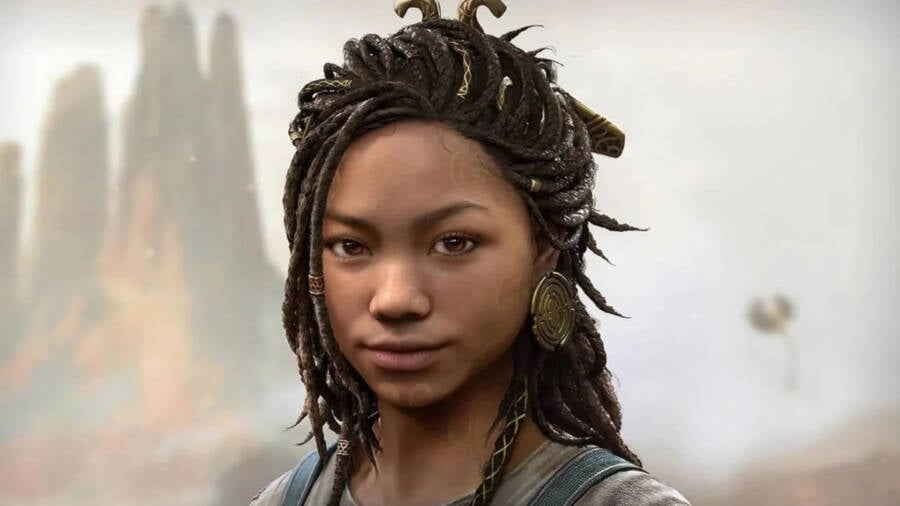
Santa Monica Studio/Sony Interactive EntertainmentAngrboda as depicted in God of War: Ragnarök (2022).
Unlike the myths that essentially relegate her as the mother of monsters, Ragnarok positions Angrboda as a romantic match for Atreus — the son of the game’s main character, Kratos.
Angrboda gifts him a bag of marbles that contain the souls of Jötunheim’s giants. After she instructs Atreus on how to resurrect them, he uses that knowledge to transfer Fenrir’s soul into the body of a giant wolf named Garm. The game notably also sees Angrboda capable of painting visions that come true.
While Angrboda also became a small part of the Vikings TV series (2013 – 2020) and Assassin’s Creed: Valhalla (2020) video game, her footprint in popular culture remains fairly sparse. Still, it seems to have been growing increasingly in recent years, denoting the enduring appeal of these ancient stories.
After learning about Angrboda, read about Yggdrasil, the sacred “world tree” of Viking lore. Then, learn about the brutal Norse warriors known as the Viking berserkers.





